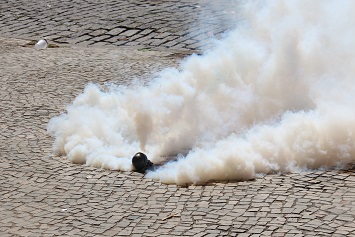In a letter dated August 13, 2020, Senators Ron Wyden and Jeff Merkley and Representatives Earl Blumenauer and Suzanne Bonamici, all of Oregon, requested that the EPA investigate the impact of tear gas use on people, air, land, and bodies of water.
The letter pointed out possible side effects the use of the chemicals might have, as well as potential long-term impacts.
“In addition to the direct health impacts on our constituents, we are also deeply concerned about the impact tear gas has had on Oregon’s environment,” the letter says. “State and local environmental and health agencies are investigating its impacts, and it is also the duty of the Federal Government to provide information that will help further these studies and make information about the environmental impacts of tear gas usage readily available to the American public.”
According to the Centers for Disease Control and Prevention, long-term exposure can cause “blindness, glaucoma, immediate death from chemical burns and respiratory failure.”
“Tear gas is the generic term for a class of compounds that cause a burning sensation,” according to a report by ProPublica. “Most law enforcement agencies in the U.S., including the Philadelphia Police Department this week, use a chemical called CS, short for 2-chlorobenzalmalononitrile. CS activates a specific pain receptor, one that’s also triggered by eating wasabi,” said Sven-Eric Jordt, a professor of anesthesiology at Duke University. “But CS is much more powerful, up to 100,000 times stronger than the sting from wasabi,” he added.
“They are really pain nerve gases,” Jordt said. “They are designed to induce pain.”
Numerous medical and public health professionals have also noted that respiratory irritation from exposure to CS gas has the potential to increase the risk for COVID-19.
The Oregon state leaders sent the letter because Portland courthouse personnel were seen hosing tear gas off the sidewalks and streets around the courthouse after it was utilized as a riot control method. These chemicals were washed into storm drains and other groundwater sources.
The letter asks for the following specific information:
- “What chemicals and/or gases have been deployed or utilized in the course of law enforcement activity in response to protests in Portland?
- “What measures are being taken to comply with material data sheets and applicable usage guidelines for these chemicals?
- “Are any grenades or cartridges expired? If so, what are the health, safety, and environmental risks from using expired gases?
- “What environmental review and risk assessments for environmental and public health has EPA conducted regarding these chemicals and/or gases?
- “What air and water quality monitoring has been conducted in the area of these discharges, and what are the results to date?”
Because tear gas is often deployed as a method of riot control in all states and use of the gas has been widespread in many states in recent months, discovering the potential long-term impacts of the use of these chemicals is important.

